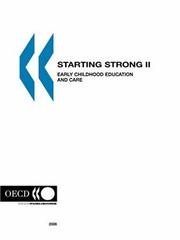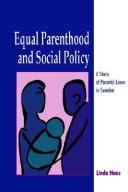| Listing 1 - 10 of 120 | << page >> |
Sort by
|
Book
Year: 1971 Publisher: Bruxelles ULB. Institut de sociologie
Abstract | Keywords | Export | Availability | Bookmark
 Loading...
Loading...Choose an application
- Reference Manager
- EndNote
- RefWorks (Direct export to RefWorks)
Book
ISBN: 9264387366 Year: 2020 Publisher: Paris : OECD,
Abstract | Keywords | Export | Availability | Bookmark
 Loading...
Loading...Choose an application
- Reference Manager
- EndNote
- RefWorks (Direct export to RefWorks)
Education, Preschool. --- Children --- Infant education --- Prekindergarten --- Preschool education --- Early childhood education --- Nursery schools --- Education (Preschool)
Book
ISBN: 9264388400 Year: 2020 Publisher: Paris : OECD,
Abstract | Keywords | Export | Availability | Bookmark
 Loading...
Loading...Choose an application
- Reference Manager
- EndNote
- RefWorks (Direct export to RefWorks)
"The first five years of a child's life is a period of great opportunity, and risk. The cognitive and social-emotional skills that children develop in these early years have long-lasting impacts on their later outcomes throughout schooling and adulthood. his report sets out the findings from the International Early Learning and Child Well-being Study in Estonia. The study assesses children's skills across both cognitive and social-emotional development, and how these relate to children's early learning experiences at home and in early childhood education and care. It is enriched by contextual and assessment information from the children's parents and educators. It provides comparative data on children's early skills with children from England and the United States, who also participated in the study, to better identify factors that promote or hinder children's early learning."--Page 4 of cover.
Education, Preschool. --- Children --- Infant education --- Prekindergarten --- Preschool education --- Early childhood education --- Nursery schools --- Education (Preschool)
Book

Year: 2017 Publisher: Washington, DC : World Bank Group,
Abstract | Keywords | Export | Availability | Bookmark
 Loading...
Loading...Choose an application
- Reference Manager
- EndNote
- RefWorks (Direct export to RefWorks)
Child welfare. --- Children --- Maternal and infant welfare --- Mothers --- Malnutrition in children --- Infants --- Nutrition. --- Finance. --- Prevention. --- Nutrition
Book
ISSN: 02534517 ISBN: 1280016590 9786610016594 0585236186 Year: 1994 Volume: no. 103 Publisher: Washington, D.C. : The World Bank,
Abstract | Keywords | Export | Availability | Bookmark
 Loading...
Loading...Choose an application
- Reference Manager
- EndNote
- RefWorks (Direct export to RefWorks)
Children --- Fertility, Human --- Child --- Fertility --- Infant --- Mortality --- Econometric models. --- Econometric models --- Cote d'Ivoire --- Ghana
Book
Abstract | Keywords | Export | Availability | Bookmark
 Loading...
Loading...Choose an application
- Reference Manager
- EndNote
- RefWorks (Direct export to RefWorks)
The human consequences of the current global financial crisis for the developing world are presumed to be severe yet few studies have quantified such impact. The authors estimate the additional number of infant deaths in sub-Saharan Africa likely due to the crisis and discuss possible mitigation strategies. They pool birth-level data as reported in female adult retrospective birth histories from all Demographic and Health Surveys collected in sub-Saharan Africa nations. This results in a data set of 639,000 births to 264,000 women in 30 countries. The authors use regression models with flexible controls for temporal trends to assess an infant's likelihood of death as a function of fluctuations in national income. They then apply this estimated likelihood to expected growth shortfalls as a result of the crisis. At current growth projections, their estimates suggest there will be 30,000 - 50,000 excess infant deaths in sub-Saharan Africa. Most of these additional deaths are likely to be poorer children (born to women in rural areas and lower education levels) and are overwhelmingly female. If the crisis continues to worsen the number of deaths may grow much larger, especially those to girls. Policies that protect the income of poor households and that maintain critical health services during times of economic contraction should be considered. Interventions targeted at female infants and young girls may be particularly beneficial.
Child development --- Developing countries --- Dropout --- Health services --- Health, Nutrition and Population --- Human development --- Infant --- Infant death --- Infant deaths --- Infant mortality --- Investments in education --- Number of deaths --- Nutrition --- Policy research --- Policy research working paper --- Population Policies --- Progress --- Public services --- Rural areas --- Unemployment --- Vital statistics --- Young girls
Book
Year: 2007 Publisher: Washington, D.C., The World Bank,
Abstract | Keywords | Export | Availability | Bookmark
 Loading...
Loading...Choose an application
- Reference Manager
- EndNote
- RefWorks (Direct export to RefWorks)
The diffusion of cost-effective life saving technologies has reduced infant mortality in much of the developing world. Income gains may also play a direct, protective role in ensuring child survival, although the empirical findings to date on this issue have been mixed. This paper assembles data from Demographic and Health Surveys (DHS) in 59 countries to analyze the relationship between changes in per capita GDP and infant mortality. The authors show that there is a strong, negative association between changes in per capita GDP and infant mortality- in a first-differenced specification the implied elasticity of infant mortality with respect to per capita GDP is approximately -0.56. In addition to this central result, two findings are noteworthy. First, although there is some evidence of changes in the composition of women giving birth during economic upturns and downturns, the observed changes in infant mortality are not a result of mothers with protective characteristics timing fertility to correspond with the business cycle. Second, the association between infant mortality and per capita GDP is particularly pronounced for periods of large contractions in GDP, suggesting the inability of developing country households or health systems (or both) to smooth resources. Simple back-of-the-envelope calculations using the estimates suggest that there may have been more than 1 million "excess" deaths in the developing world since 1980 as a result of large, negative contractions in per capita GDP.
Developing countries --- Female education --- Global Development --- Health Monitoring and Evaluation --- Health, Nutrition and Population --- Human Development --- Infant --- Infant Mortality --- Policy Research --- Policy Research Working Paper --- Population Policies --- Progress --- Public Services

ISBN: 1281746959 9786611746957 926403546X 9264035451 Year: 2006 Publisher: Paris : OECD,
Abstract | Keywords | Export | Availability | Bookmark
 Loading...
Loading...Choose an application
- Reference Manager
- EndNote
- RefWorks (Direct export to RefWorks)
This review of early childhood education and care (ECEC) in twenty OECD countries describes the social, economic, conceptual and research factors that influence early childhood policy. These include increasing women’s labour market participation; reconciling work and family responsibilities on a more equitable basis for women; confronting the demographic challenges faced by OECD countries; and in particular, addressing issues of access, quality, diversity, child poverty and educational disadvantage. Starting Strong II outlines the progress made by the participating countries in responding to the key aspects of successful ECEC policy outlined in the previous volume, Starting Strong (OECD, 2001). It offers many examples of new policy initiatives adopted in the ECEC field. In their conclusion, the authors identify ten policy areas for further critical attention from governments. The book also presents country profiles, which give an overview of ECEC systems in all 20 participating countries.
Education, Preschool --- Government policy --- Children --- Infant education --- Prekindergarten --- Preschool education --- Education (Preschool) --- Early childhood education --- Nursery schools
Book
ISBN: 9789264276116 Year: 2017 Publisher: Paris : OECD Publishing,
Abstract | Keywords | Export | Availability | Bookmark
 Loading...
Loading...Choose an application
- Reference Manager
- EndNote
- RefWorks (Direct export to RefWorks)
Early childhood education and care (ECEC) can help lay the foundations for future skills development, well-being and learning. Having timely, reliable and comparable international information is essential to help countries improve their ECEC services and systems. For over 15 years, the OECD has been conducting policy analysis and gathering new data on ECEC. For the first time, this report brings together all the key ECEC indicators in one volume. It presents an exhaustive overview of ECEC systems and provision as well as trend data and information on recent reforms. The report takes a hard look at issues such as access and governance, equity, financing, curriculum, the teaching workforce and parent engagement. Key challenges for improving the ECEC sector are identified.With around 45 charts and data for the 35 OECD countries and a number of partner countries, the publication also includes a great deal of new material. It offers new data on ECEC provision and intensity of participation for children under the age of three (based on an improved typology of settings). It also presents new indicators on the profile of ECEC staff (e.g. level of qualification, teacher salary and organisation of working time) and on equity in access to ECEC. New PISA 2015 analyses help highlight the relationship between the number of years of ECEC and academic performance at age 15, and the effects of ECEC attendance on health and well-being, and mothers’ employability.
Education, Preschool --- Government policy --- Children --- Infant education --- Prekindergarten --- Preschool education --- Early childhood education --- Nursery schools --- Education (Preschool)

ISBN: 0791409570 0791409589 058506041X 9780585060415 1438405308 9780791409589 9780791409572 Year: 1992 Publisher: Albany, NY : State University of New York Press,
Abstract | Keywords | Export | Availability | Bookmark
 Loading...
Loading...Choose an application
- Reference Manager
- EndNote
- RefWorks (Direct export to RefWorks)
Parental leave --- Labor & Workers' Economics --- Business & Economics --- Family leave --- Infant care leave --- Leave for parenting --- Leave of absence --- E-books --- Parental leave - Sweden
| Listing 1 - 10 of 120 | << page >> |
Sort by
|

 Search
Search Feedback
Feedback About UniCat
About UniCat  Help
Help News
News